|
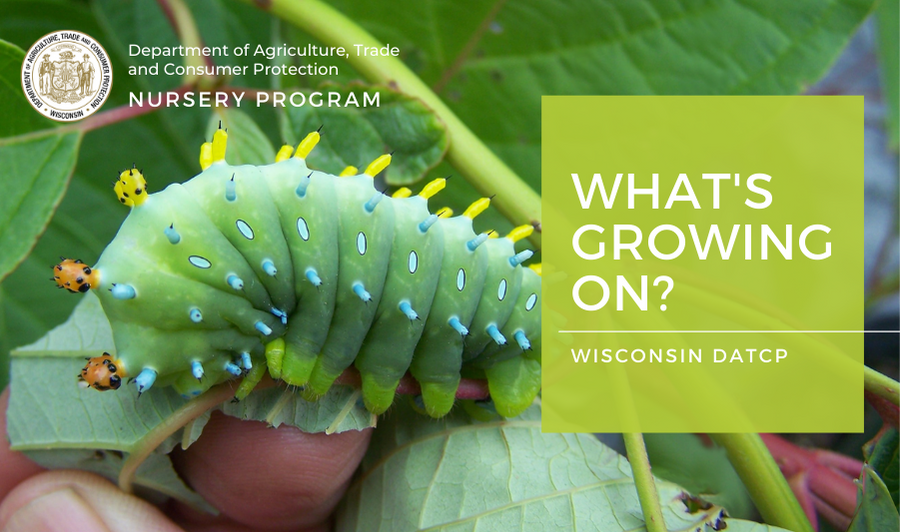 _____________________________________
Dear Wisconsin nurseries, Christmas tree growers, and gardeners:
Degree day accumulations (simple B50) as of August 13th were 1971 in Madison, 1909 in Racine, 1810 in Green Bay, and 1507 in Wausau.
With locations throughout the northern half of the state still under 1500 growing degree days, 1356 in Medford and 1330 in Crandon, insects entering vulnerable life stages for treatments are adult white pine weevils, second generation eastern spruce gall adelgids adults and second generation pine needle scale crawlers.
Take a moment to read through a few updates from the DATCP nursery program. Please send any feedback, questions, or ideas for future e-news updates to datcpnursery@wisconsin.gov.
Having trouble viewing this email? View it as a Web page.
_____________________________________
|
|
|
DATCP inspectors will begin conducting Christmas tree field inspections in September. Regulatory pests are the primary focus of field inspections. Growers shipping out of the Lymantria dispar or spongy moth (formerly gypsy moth) quarantine are required to be inspected and adhere to shipping restrictions if spongy moth egg masses are found on or near Christmas tree stock.
Christmas tree lot inspections are conducted after field inspections, from mid-November until Christmas in late December. Inspectors will be on the lookout for both Spotted Lanternfly (SLF) and Elongate Hemlock Scale (EHS). These invasive pests are not currently found in Wisconsin but human movement of materials, including Christmas trees or holiday décor imported from infested areas are a pathway of introduction. Inspectors have intercepted EHS on infested cut Fraser and Balsam Christmas trees, boughs, wreaths, evergreen décor, and hemlock nursery stock brought in from out of state suppliers in the 20 states where EHS is currently found over 40 times since 2014.
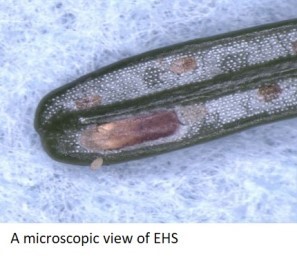
EHS (Fiorinia externa) is found on the undersides of needles and causes needle yellowing and needle loss, and contributes to tree mortality in the presence of other stressors. The insect is surrounded by a hard waxy coating, creating a protective scale. There are 1-2 generations produced per year and each generation feeds during multiple lifestages, making EHS difficult and expensive to control with pesticide applications.
|
Inspections are also focused on detecting spotted lanternfly (Lycorma delicatula). Similar to spongy moth and EHS, spotted lanternfly is more widely spread by human movement. Native to China, India, Japan, and Vietnam, the insect was found in Pennsylvania in 2014. Since then, it has been detected in Connecticut, Delaware, Indiana, Maryland, Massachusetts, New Jersey, New York, North Carolina, Ohio, Virginia, and West Virginia.
Nymphs emerge in late spring and early summer. Nymphs have a wide range of host plants including fruit crops, grapes, hops, and hardwoods. Adults, present in late July, prefer to feed on grapevines (Vitis vinifera) and tree of heaven (Ailanthus altissima). In the fall, egg masses are laid on host plants or any outdoor item with a suitable smooth surface. The egg masses are 1-1.5 inches long, grey and waxy looking. With time, they harden and crack, looking similar to dried mud.
|
|
 Fresh Spotted Lanternfly egg mass | L.Barringer, Pennsylvania Department of Agriculture, Bugwood.org
|
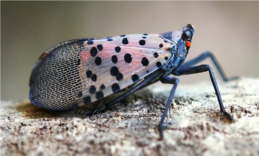 Adult Spotted Lanternfly | L.Barringer, Pennsylvania Department of Agriculture, Bugwood.org
|
|
|
_____________________________________
|
|
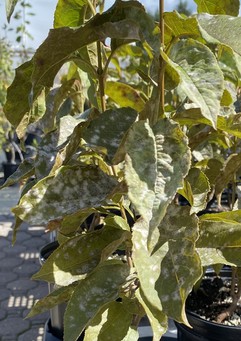
Powdery mildew is a common plant disease that is easily recognized by the white powder-like fungal growth that can cover leaves, stems, and other parts of the infected plant.
While powdery mildew does not usually cause significant plant decline and is often only unsightly, the disease can sometimes cause significant economic losses, depending on the plant infected and the severity of infection. Many species of fungi can cause powdery mildew disease worldwide. Powdery mildew fungi are generally host-specific, meaning the species of powdery mildew that infects a peony plant is different from the species that infects a bee balm plant.
In 2021, DATCP detected the powdery mildew species Erysiphe viburniphila for the first time in Wisconsin. The powdery mildew was found on two Viburnums at a nursery in Adams County. Although the species Erysiphe viburniphila was only recently described (2020) and detected in Wisconsin, it has likely been in the state for a long time and is likely widespread. Viburnums are seldom negatively impacted long-term by powdery mildew infections.
To reduce powdery mildew issues, growers should reduce humidity and increase air flow between plants, avoid over watering, and remove infected plant debris at the end of the growing season.
|
_____________________________________
|
|
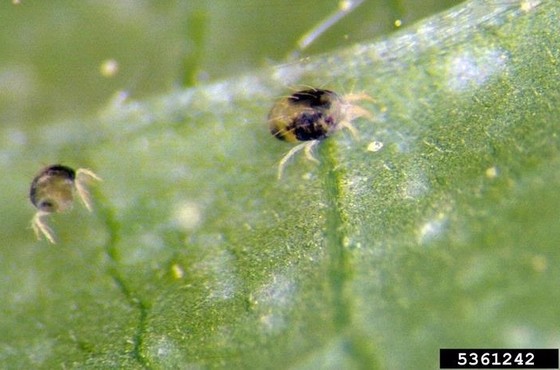 Twospotted spider mite adults | Frank Peairs, Colorado State University, Bugwood.org
Spider mites are a common problem for indoor and outdoor plants, especially during hot, dry summer weather. There are approximately 1,200 species of spider mites in the family Tetranychidae. The most common spider mite is the twospotted spider mite (Tetranychus urticae). This eight legged arachnid is very tiny, about a 1/50th of an inch long with yellow-orange coloring with two dark spots, one on each side of their body. They will attack more than 300 hundred different species of plants, which includes all of the fruit tree crops, vegetables, and ornamentals such as arborvitae, spruce, and rose. The leaves of infested plants often have a bronzed or stippled look when infestations become heavy. White webbing may also be present. Spider mites can make plants look unsightly, stunt growth, and cause death. Prevent outbreaks by not fertilizing during droughts and properly watering plants.
Utilizing multiple forms of management is very important in controlling the mite population.
- Sanitation: Greenhouses should be clean and weed free.
- Monitoring: Inspect plants prior to introducing them into your operation. If possible, isolate and treat infested plants to prevent further infestation.
- Biological Control: Greenhouses can purchase predatory mites to control the population. Lady bugs are also beneficial for controlling outdoor infestations.
- Chemical Control: Miticides are most effective at controlling the adults and nymphs so a second application needs to be made as eggs hatch. Insecticidal soap or horticultural oil sprays such as neem oil can also help reduce the mite population when applied directly on the mites, especially targeting the undersides of leaves.
_____________________________________
|
|
|
Zimmerman pine moth larva in a pitch mass | DATCP S. Hankin
|
|
|
Zimmerman pine moth (Dioryctria zimmermani) larvae were observed at nurseries in both Dane and Jefferson counties in early July. The larvae were discovered after digging into pitch masses on white pine nursery stock in Dane County and Austrian pine in Jefferson County. The pitch masses are created by larval feeding and easy to spot along the trunk at branch collars. Zimmerman pine moth can also infest Scotch pine. There is one generation per year. Larvae can be found feeding within the pitch masses in the spring and early summer. Adult moths emerge in late July to early August and lay their eggs shortly after. Eggs hatch and larvae overwinter under the bark. To culturally control for this pest, remove and burn infested trees. Chemically, in early spring, a preventative insecticidal trunk drench can be effective for widespread infestations.
_____________________________________
|
|
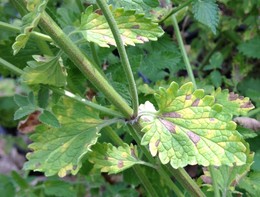 Symptoms of foliar nematodes in catmint | DATCP T. Allen
|
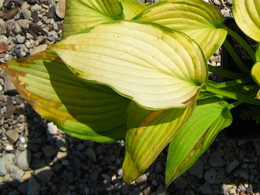 Symptoms of foliar nematodes in hosta | DATCP image
|
|
|
As we approach the end of the growing season, signs of foliar nematode (Aphelenchoides sp.) feeding become more apparent. As the name suggests, foliar nematodes feed on the foliage of a variety of plants (ornamental perennials, trees, and agricultural crops). Foliar nematodes can lead to severe defoliation in hostas if populations are allowed to grow. Symptoms of foliar nematodes feeding in hostas include angular necrotic blotches bordered by leaf veins. The blotches may eventually fall out late in the season leaving a shot-holed appearance behind. Foliar nematodes are most commonly found on hostas, but can affect other herbaceous ornamentals (ex. anemone, chrysanthemum, fern, veronica) and woody ornamentals (ex. azalea, elm, privet), as well as some fruit and vegetable crops.
Foliar nematodes spread by splashing water. Avoiding overhead irrigation could help prevent further spread. Inspecting new plant material prior to planting can also prevent introducing foliar nematodes into new growing areas. In order to control for foliar nematodes, the best course of action is to be vigilant about removing, bagging, and disposing of infected plants from growing areas as soon as signs and symptoms arise. There are currently no chemical controls available. Since foliar nematodes are extremely difficult to eradicate, nursery stock found to be infested with foliar nematodes must be removed from sale and destroyed.
_____________________________________
|
|
|
|
|